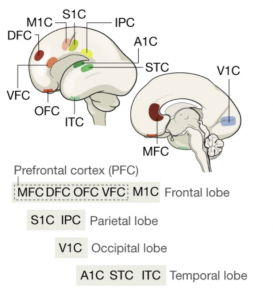When Our Brains Change
Written by: Shiqi Cheng
How do our brains develop? When do we begin to have thoughts? Is there a beginning to the notion and consciousness, and if so, when does it start? Recent research has shown that about four or five months after conception, a burst of synapses develops in the prefrontal cortex (PFC) of the prenatal baby. This is when the unique properties of human communication begin to form; the developing brain acquires the ability to think abstract thoughts, effectively use language, and accomplish complex social interactions.
How do our brains develop?
While developmental mechanisms that dictate the patterning of the cerebral cortex of rodents have been recently characterized, the development of primate PFCs still remain unknown. However, there have been new studies that explore the existence of retinoic acid ( RA) as a large factor in PFC development. RA is a signaling molecule that regulates neural development and function in the human brain in order to identify the genes that are regulated by retinoic acid during fetal development.
The concentration of retinoic acid, which is a byproduct of Vitamin A, was found at various levels in different animals, including humans, macaque monkeys, and mice midway during fetal development. This variance could be a large cause of the different levels of PFC development each of these species has; higher concentrations of RA have shown to cause more complex PFC developments, while lower concentrations often result in simpler PFC structures. Additionally, RA is essential for the development of all organs in the body and is regulated meticulously in organisms.
Data collected by a group of scientists from Yale showed that RA-related genes were upregulated (increased in rate) in the mid-fetal frontal cortex. Figure 1 shows the different areas analyzed in the mid-fetal brain, with four of the regions being in the PFC. RA increases dramatically in the PFC during the second trimester for humans, monkeys, and mice which is the most important time for the formation of neural circuitry and connections to perform social activities.
Figure 1

Diagram of the analyzed eleven areas of the human mid-fetal brain
Source: Nature
Effects of Blocking Signals and Genes
When researchers blocked the RA signals in the PFC of mice, they failed to develop circuits in the brain that are essential for working memory and cognition. In humans, disparities in RA concentration were found in patients with schizophrenia or autism spectrum disorders.
When the CYP26B1 gene in mice, which limits the activity of RA beyond the PFC, was blocked, many of the areas of their brain associated with cognition began to resemble the synaptic wiring of the prefrontal cortex. This shows how RA plays an essential role in the expansion of the PFC which leads to higher brain complexity in humans and primates.
More Developed Portions of the Brain
The same research group at Yale also focused on why synaptic growth starts in the PFC but proceeds to diminish as they near the sensory and motor neurons towards the back of the brain. They focused on the CBLN2 gene which is directly regulated by RA. It was found that CBLN2 is switched on earlier in the front of the brain causing the gene to be expressed for longer and over a wider area in the PFC in comparison to other regions in the brain.
Conclusion
Overall, we can see that changes in retinoic acid concentration in the prefrontal cortex in mid-fetal stage humans dictate many essential brain connections in regards to cognition, emotions, and actions. These connections are seen to be more developed in human brains compared to primates and mice, likely due to higher levels of genes that propel RA production. Additionally, subtle changes in RA and other gene levels have been shown to cause various neuropsychiatric disorders. While our brain is very complicated, this research is a step closer to understanding how we develop to be the people we are.
References and Sources
Shibata, M., Pattabiraman, K., Lorente-Galdos, B., Andrijevic, D., Kim, S.-K., Kaur, N., Muchnik, S. K., Xing, X., Santpere, G., Sousa, A. M. M., & Sestan, N. (2021, October 1). Regulation of prefrontal patterning and connectivity by retinoic acid. Nature News. Retrieved March 16, 2022, from https://www.nature.com/articles/s41586-021-03953-x
Shibata, M., Pattabiraman, K., Muchnik, S. K., Kaur, N., Morozov, Y. M., Cheng, X., Waxman, S. G., & Sestan, N. (2021, October 1). Hominini-specific regulation of CBLN2 increases prefrontal spinogenesis. Nature News. Retrieved March 16, 2022, from https://www.nature.com/articles/s41586-021-03952-y